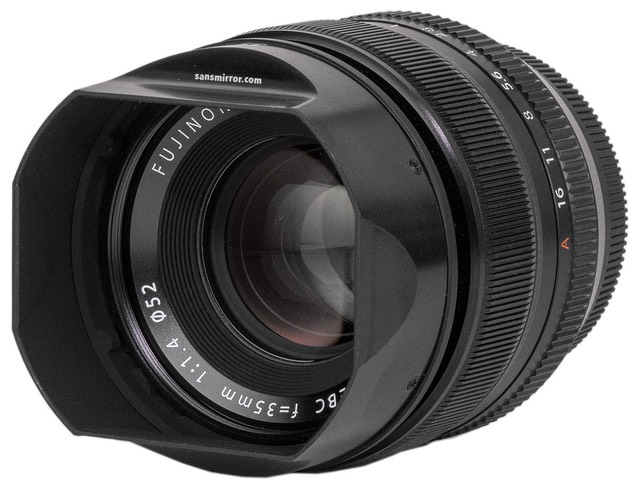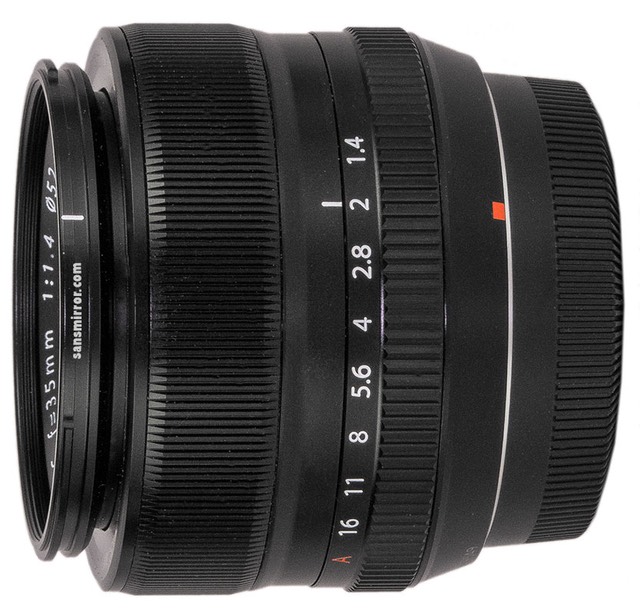
What is It?
What we have here is your basic "normal, fast prime." Not my favorite focal length, for sure, but definitely a useful one for street and event shooting.
Again we have the basic plastic on metal build quality of all the Fujinons, with an aperture ring (only to f/16) next to the mount and a fly-by-wire focus ring further forward. No depth of field markings are available.

Filter thread size is 52mm, like the 18mm. Fujifilm's lens hood for the 35mm is unusual, going from round at the bayonet to a squeezed rectangular up front. This definitely provides for good front element shading.
How's it Handle?
So let's start with that lens hood: it bayonets on better than any of the other Fujifilm hoods. Finding the attach point and getting a secure click-in when mounted are exactly as they should be (not always true of bayonets). The problem with the lens hood is the lens cap. It comes with a push on rubber cap, but this cap has a strong tendency to come off in the bag, or when rubbed against outside the bag. The more you use it, the looser the cap fit gets and the worse the problem gets. This is probably one of those lenses where you might want to go with a neoprene hat instead of a cap (for example, the Op/Tech Micro [advertiser link]).
As with a couple of my Fujinon lenses, the aperture ring on my 35mm is a bit too loose, and somewhat easy to dislodge. It's not as bad as my 14mm, which has a very loose ring, but it's also nowhere near as tight as the ring on my 18mm. Come on Fujfilm, let's get this right and consistent!
Be aware that—especially with the hood mounted—this is a fairly big lens and is going to block some of the optical viewfinder on the X-Pro1.
How's it Perform?
Let's start with the MTF numbers, because I think many will find them a bit surprising. The central area is exceptional. I suspect that at f/4 that you can't get much, if anything, more out of the center of the 16mp X-Trans sensor. But the center is also excellent right from f/1.4 and stays that way until diffraction really starts to eat into things at about f/11.
The edges and corners are a different story. At f/1.4 the corners are poor and the edges aren't all that much better. The edges and corners improve at every aperture up to about f/8, but it's only at f/5.6 that they're in good balance with the center. Yes, you read that right: at f/1.4, f/2, f/2.8, f/4, the edges and corners are visibly weaker than the center area. Indeed, if corners are really important, I wouldn't shoot with this lens faster than f/2.8.
I know a lot of others have written about how exceptional this lens is, but I'm not seeing it the same way. It's exceptional in the center, sure. It's actually fairly weak from f/1.4 to f/2.8 in the corners.
Linear distortion: there's perhaps 1% barrel distortion in pure raw images, a bit less in JPEG. On my sample, there's a bit of unevenness to the distortion, as if there's a bit of a wave at the extremes. Still, the low level of it isn't enough to worry about. Even with a basic distortion correction things tighten up enough that I'd find the results acceptable.
Vignetting: not bad. Wide open there's perhaps a stop of vignetting overall in the extreme corners. This is reduced to a half stop by f/2.8, and the lens has a fairly reliable third of a stop at smaller apertures, which is fine.
Chromatic aberration: lateral chromatic aberration is low; this lens is good but not perfect. I can see some lateral aberrations on hard contrast edges, but they're not wide or obnoxious. For an f/1.4 lens, even longitudinal chromatic aberration was low. Some people wouldn't be able to see it even on black and white subjects (where foreground out of focus areas would go slightly purple, backgrounds green). It's there and I can measure it, but I haven't seen a fast prime that handles longitudinal chromatic aberration this well in a long, long time. Indeed, this Fujinon is better than any Nikkor prime I've tested in the last 15 years in that respect.
Bokeh: surprisingly, there was clear fringing in out of focus highlights despite the good chromatic aberration results. That's a little perplexing to me. It's not bad, though it does put a slight color at the edge of the blurs that wasn't there. Stopping down makes for busy, uglier bokeh. In my sample the aperture blades didn't form a perfect heptagon, and so the bokeh elongates and gets clear flat edges with jagged points. My advice: if blurred background smoothness is important, stick to f/1.4.

Over and over I've been impressed with the Fujinon lenses in their mid-range apertures. It's hard to find any fault of the lens with this image. I will admit, however, that the Fujifilm Cyan Sky syndrome finally got to me: I applied the poor person's polarizing filter to this image. Wait, what's that? Pull up the HSL sliders in your converter. Take the luminance of Cyan (Adobe's Aqua [sic]) and Blue down, and move the hue of both more towards blue. This doesn't always work for some images (watch shadow areas, which may have a fair amount of blue in them), but it works surprisingly well for many.
Final Words
The 35mm is probably the most uneven performer of the Fujinons. Fortunately, it's never bad in the central area, but it is not sharp in the corners until you've stopped well down from wide open. The not-so-great bokeh also was a surprise to me, as generally the other Fujinon's, even the zooms, have been at least good in this respect.
That said, the lens does what you expect it to: give you great central capture in low light. At f/1.4 it's a stop faster than any of the other lenses we have available right now, so we're getting the trade-off that comes with really fast glass.
For my event shooting, this lens has turned out to be better in practice than it tests. Thus, I can say with some confidence that if you need "fast normal," then this is a reasonable choice. However, with the entrance of Zeiss 32mm f/1.8, you now have a choice (though a more expensive one).
Support this site by purchasing the lens from this advertiser:
